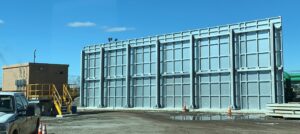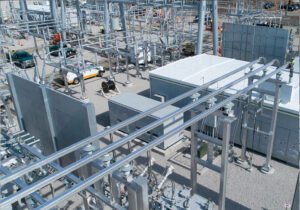Understanding Passive Fire Protection Systems: A Guide to Enhancing Safety
Passive fire protection (PFP) systems are not only crucial for buildings and their occupants but also play a significant role in safeguarding critical infrastructure, such as electrical transformers. These systems, including specialized fire barriers, are essential for containing fires and preventing chain reactions that could lead to the loss of critical infrastructure.
What is Passive Fire Protection for Electrical Transformers?
Passive fire protection (PFP) for electrical transformers involves the use of specialized barriers designed to resist fire and prevent its spread to neighboring transformers. These systems are vital for maintaining the integrity of electrical systems during a fire and preventing catastrophic failures that could result in widespread outages and damage to essential infrastructure.
Key Components of PFP for Electrical Transformers
Fire barriers specifically designed for electrical transformers are crucial components of PFP systems. These barriers are constructed using fire-resistant materials and coatings to withstand high temperatures and prevent the spread of fire in the event of a transformer failure or explosion.
Benefits of Implementing PFP for Electrical Transformers
Implementing PFP systems for electrical transformers brings numerous benefits, including the preservation of critical infrastructure, prevention of chain reactions, and mitigation of potential fire-related outages. By containing fires and preventing them from spreading to adjacent transformers, these systems help ensure the reliability and resilience of electrical networks, even during fire emergencies.
How Do Fire Barriers Safely Separate Transformers?
Fire barriers effectively separate electrical transformers, preventing the spread of fire and minimizing the risk of chain reactions. These barriers are constructed using fire-resistant materials and coatings that can withstand extreme temperatures, providing a robust defense against fire propagation.
In the event of a fire or explosion in one transformer, the fire barriers surrounding it act as a containment measure, preventing the flames from reaching neighboring transformers. This containment not only limits the extent of damage but also prevents the escalation of the fire, thereby safeguarding critical infrastructure and minimizing the risk of widespread outages.
Maintaining PFP Systems for Electrical Transformers
Regular maintenance and inspections of PFP systems for electrical transformers are essential to ensure their effectiveness in the event of a fire emergency. Routine checks should include examining fire barriers for any signs of damage or deterioration and ensuring that all components are in proper working order. Compliance with fire safety regulations and standards is also crucial to guarantee the integrity of PFP systems and the safety of electrical infrastructure.
Importance of Protecting Wires and Cables
Protecting wires and cables is a crucial aspect of passive fire protection, ensuring that critical systems such as lighting, communication, and fire alarms remain operational during a fire. This protection is vital for maintaining illumination in escape routes, enabling effective communication among occupants and emergency responders, and ensuring that fire detection systems can continue to operate. Cable Tray Fire Stopping Barriers are a perfect solution offered by Sinisi Solutions to protect wires and cables to critical systems.
Specialized fire-resistant coatings, wraps, and conduits are employed to shield electrical cables from heat and flames, preventing electrical failures that could exacerbate the fire situation or hinder evacuation efforts. Such measures not only enhance the safety of occupants but also contribute to the resilience of the infrastructure against fire damage.
Types of Fire Barriers
Fire barriers come in various systems to split buildings into sections and stop fire and smoke from spreading. These systems get sorted by their uses and how well they resist fire. You’ll see firewalls, for example. These are solid, unbroken structures that reach from the ground up to the roof. There are also fire partitions. These are walls inside that go from the floor up to the ceiling. Then, there are fire-rated doors and windows. They’re made to hold back fire for a certain amount of time. And, there are fire dampers. These get put in ducts to block fire and smoke from moving through the air system. Each kind of fire barrier has its job in the larger plan of passive fire protection. This helps keep a building safe and sound when there’s a fire.
Maintaining Your Passive Fire Protection Systems
For passive fire protection systems to remain effective, regular maintenance and inspections are crucial. This section will discuss the importance of routine checks and updates to ensure that PFP systems continue to provide maximum protection.
Routine Maintenance Tips
Keeping passive fire protection (PFP) systems in top condition is essential for their effectiveness in the event of a fire. Regular maintenance should include checking fire doors to ensure they close properly and are free from damage, inspecting firestops for any signs of deterioration or breaches, and ensuring that fire-resistant materials are not compromised by construction or renovation activities. It’s also important to ensure that all components of the PFP system are accessible and not obstructed by furniture or equipment. Routine maintenance not only extends the lifespan of these systems but also ensures they function as intended, providing maximum protection for buildings and their occupants.
Inspection and Compliance
Regular inspections of passive fire protection systems are critical to ensure they meet local fire safety standards and regulations. These inspections should be carried out by qualified professionals who can identify potential issues and recommend corrective actions. Compliance with fire safety regulations not only protects buildings and their occupants but also helps avoid legal penalties and fines. Keeping detailed records of inspections and maintenance activities is also important, as it provides a history of compliance and system integrity. By adhering to inspection schedules and ensuring compliance with fire safety laws, building owners and managers can significantly enhance the safety and security of their properties.
Conclusion: Ensuring the Resilience of Electrical Infrastructure
Passive fire protection systems play a vital role in safeguarding electrical transformers and critical infrastructure from the devastating effects of fire. By implementing robust fire barriers and conducting regular maintenance, we can ensure the reliability and resilience of electrical networks, minimizing the risk of outages and preserving essential services for communities and industries. Prioritizing the protection of electrical infrastructure through effective PFP measures is essential for building a safer and more resilient tomorrow.
A Safer Tomorrow Begins with Today’s Fire Protection
Passive fire protection systems are an integral part of a building’s fire safety strategy, offering silent but crucial defense against the spread of fire. By understanding and properly maintaining these systems, building owners and occupants can significantly enhance their safety and compliance with fire safety regulations. Emphasizing the importance of these systems encourages a safer environment for everyone.
Get Fire-Safe Today with Sinisi Solutions
Ready to take your fire safety to the next level? Sinisi Solutions is here to help. With our expertise in passive fire protection, we’re dedicated to enhancing the safety and compliance of your building. Don’t wait for an emergency to realize the importance of fire safety. Visit us at 20 Abe Voorhees Drive, Manasquan, New Jersey, 08736, or give us a call at (201) 350-1177. For more information on how we can safeguard your premises, check out our services at https://firebarrierexperts.com/. Let’s create a safer environment together.




